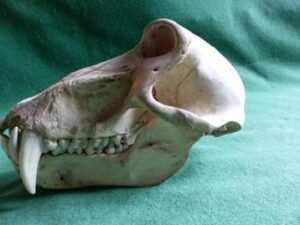Omnivore
Baboon

Figure 8 Baboon male yawning [Tambako the Jaguar. Available from: https://wordpress.org/openverse/image/5161af01-d89c-4e28-9f17-3dc9b6088cc2. Accessed 07 July 2022].
Dental Formula: I2/2𝐶1/1𝑃2/2𝑀3/3
This skull (below) in our collection is that of a baboon – belonging to the genus Papio. Whilst baboons are well known for their very long canines (Figure 9), they are actually mainly used to scare away predators and assert dominance rather than eating prey. 90% of the baboon’s diet consists of grass, seeds, fruit, flowers and other forms of plant matter ground between the pre-molars and molars. However, they will also eat insects, fish, birds, vervet monkeys and sometimes even small antelope. Classified as old world monkeys, they share the same dental formula as humans, although both their incisors and canines are significantly larger than ours. With predators like lions and cheetahs, baboons will open their mouths wide and bring their upper lip back to show off their sharp fangs in the hope of scaring away the predator. The image of the baboon doing this (above) is the reason why baboons are considered bringers of evil in several different cultures.
 Figure 9 Close up of Baboon’s Canines and Incisors [Photographed by James D’Arcy (2018)]
Figure 9 Close up of Baboon’s Canines and Incisors [Photographed by James D’Arcy (2018)]


Figure 10 Side View of Baboon Skull; Figure 11 Frontal view of Baboon Skull [Photographed by James D’Arcy (2018)]